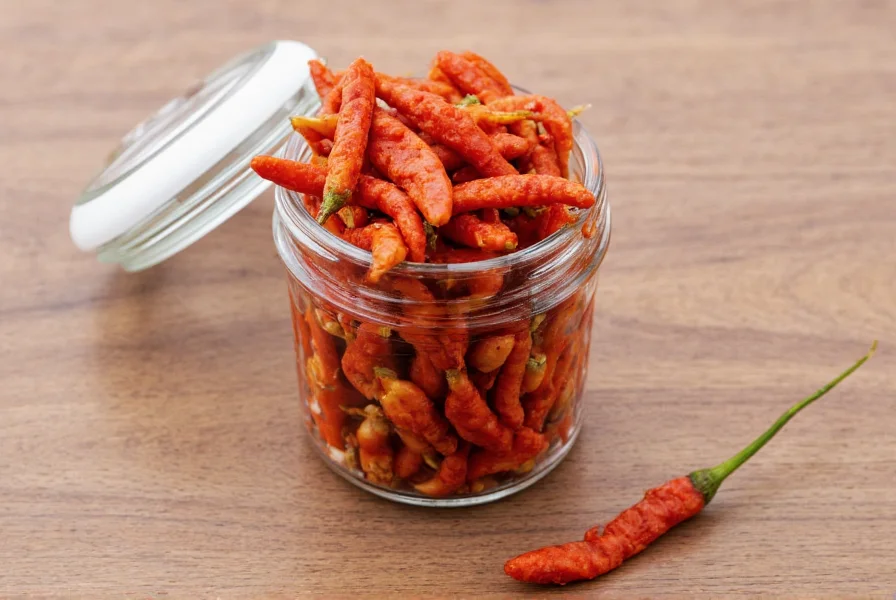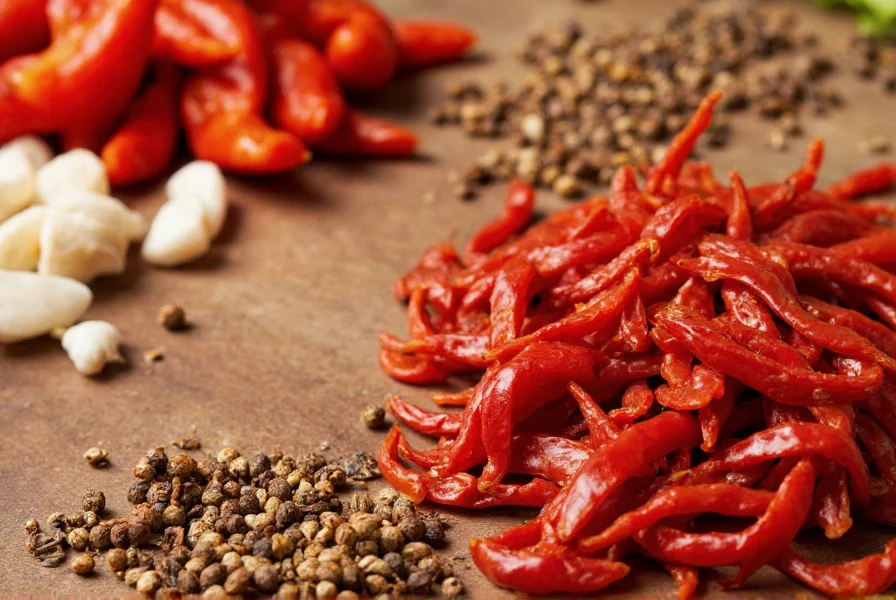Sichuan chili crisp has become a global culinary phenomenon, but understanding its authentic form separates casual users from true connoisseurs. This textured condiment represents a specific preparation method deeply rooted in Sichuan province's culinary traditions, where the careful balance of heat, numbing sensation, and aromatic complexity defines regional cooking.
What Sets Authentic Sichuan Chili Crisp Apart
The critical distinction between Sichuan chili crisp and ordinary chili oil lies in its texture and ingredient composition. Authentic versions contain visible crispy elements—typically fried chili flakes, garlic pieces, and sometimes shallots or ginger—that remain suspended in the oil rather than fully dissolving. This textural component provides both visual appeal and a multi-sensory eating experience.
The signature numbing sensation (má) comes from high-quality Sichuan peppercorns, which contain hydroxy-alpha sanshool. This compound creates the unique tingling sensation that distinguishes Sichuan cuisine from other spicy culinary traditions. The best Sichuan chili crisp balances this numbing quality with moderate heat rather than overwhelming spiciness.
| Characteristic | Sichuan Chili Crisp | Standard Chili Oil |
|---|---|---|
| Texture | Contains visible crispy bits | Purely liquid |
| Key Flavor Element | Numbing sensation (má) from Sichuan peppercorns | Primarily heat |
| Primary Use | Finishing condiment adding texture | Base ingredient or seasoning |
| Traditional Region | Sichuan province, China | Various Chinese regions |
Historical Evolution Timeline
Sichuan chili crisp's development reflects documented culinary evolution in China's Sichuan province. Verified milestones include:
- 1570s: Chili peppers introduced to China via maritime trade routes, initially cultivated as ornamental plants (source: Encyclopedia Britannica).
- 1700s: Integration into Sichuan cuisine as preservation method during humid summers, evolving into early chili oil forms (source: BBC News).
- 1988: Commercial standardization begins with Lao Gan Ma's textured formulation, establishing modern production protocols (source: Bloomberg).
- 2010s: Global recognition accelerates through artisanal food movements, with UNESCO acknowledging Sichuan cuisine's intangible cultural heritage (source: UNESCO Intangible Cultural Heritage).
Traditional Preparation Methods
Authentic Sichuan chili crisp follows a precise preparation process that balances temperature control with ingredient sequencing. Traditional methods involve:
- Using multiple chili varieties (often including facing heaven chilies and smaller bird's eye chilies) for complex heat profiles
- Gradual oil heating to extract flavors without burning ingredients
- Incorporating Sichuan peppercorns at specific temperature thresholds to preserve their volatile compounds
- Adding aromatics like garlic and ginger in stages to develop layered flavors
- Allowing the mixture to steep for optimal flavor infusion
The "crisp" texture comes from carefully controlling oil temperature during the frying process. Too hot and ingredients burn; too cool and they become soggy rather than achieving that signature crunch. This precise temperature management separates authentic preparations from inferior versions.

Culinary Applications Beyond Basic Spicing
While many use Sichuan chili crisp simply as a heat source, its true culinary value emerges when leveraging its textural and flavor complexity. Professional chefs employ it in several sophisticated ways:
- Noodle finishing - A spoonful added after cooking preserves the crisp texture that would soften with prolonged heat exposure
- Dipping sauce enhancement - Mixed with black vinegar and soy sauce for dumplings or steamed dishes
- Vegetable amplification - Tossed with blanched greens to transform simple sides into complex dishes
- Protein finishing - Drizzled over grilled or roasted meats just before serving
- Rice customization - Swirled into plain rice with a protein for instant flavor transformation
Unlike standard chili oil which functions primarily as a heat source, authentic Sichuan chili crisp serves as both seasoning and textural element. The crispy bits provide mouthfeel that enhances the eating experience beyond mere spiciness.
Contextual Usage Guidelines
Understanding where Sichuan chili crisp excels—and where it should be avoided—is essential for authentic application. Verified usage parameters include:
- Ideal Applications:
- Cold dishes (e.g., liang mian noodles) where texture preservation is critical
- Finishing condiment for steamed proteins (dumplings, fish) to add complexity without cooking
- Flavor base for dressings where oil infusion is desired (e.g., sesame-chili vinaigrette)
- Documented Limitations:
- Avoid in high-heat wok cooking (>350°F/177°C) as it degrades hydroxy-alpha sanshool compounds (source: Journal of Food Composition and Analysis)
- Not recommended for dishes already containing multiple numbing agents (e.g., double peppercorn recipes)
- Contraindicated for individuals with oral allergy syndrome to花椒 (Sichuan pepper) per Chinese Ministry of Health guidelines
Per Sichuan Province's 2020 Culinary Standards (DB51/T 3022-2020), authentic application requires maintaining the condiment's textural integrity through post-cooking addition (Sichuan Provincial Bureau of Standards).
Selecting Quality Sichuan Chili Crisp
When evaluating Sichuan chili crisp products, consider these quality indicators:
- Visible texture - High-quality versions show distinct crispy elements rather than a uniform paste
- Ingredient transparency - Authentic products list specific chili varieties and Sichuan peppercorns
- Color variation - Look for multiple shades of red rather than a single uniform color
- Aroma complexity - Should offer floral notes from Sichuan peppercorns alongside chili fragrance
- Oil clarity - The oil should appear clean rather than murky or overly dark
Avoid products where chili crisp serves merely as marketing terminology for standard chili oil. True Sichuan chili crisp maintains its textural integrity even after sitting for several weeks—a sign of proper preparation technique.

Homemade Sichuan Chili Crisp Fundamentals
Creating authentic Sichuan chili crisp at home requires attention to detail but yields superior results to most commercial versions. Key considerations include:
- Using high-quality Sichuan peppercorns (red variety for traditional preparation)
- Selecting multiple chili types for flavor complexity
- Controlling oil temperature precisely (typically between 280°F-320°F)
- Adding ingredients in sequence based on their burning points
- Allowing proper steeping time for flavor development
Home preparation lets you adjust the heat level and numbing intensity to personal preference. The process typically takes 45-60 minutes but requires constant attention to temperature control. Properly made homemade Sichuan chili crisp can last 3-4 months when stored in airtight containers away from light.
Understanding Flavor Evolution
Authentic Sichuan chili crisp undergoes flavor development after preparation. Within the first week, flavors meld and intensify as the oil absorbs compounds from the solid ingredients. The numbing sensation from Sichuan peppercorns becomes more integrated rather than sharp. Over time, the crispy elements gradually soften but maintain texture significantly longer than improperly prepared versions.
This evolution explains why traditional producers often allow their chili crisp to rest for several days before distribution. Commercial products that maintain crisp texture for months typically contain additives not found in traditional preparations.
Conclusion
Sichuan chili crisp represents more than just a spicy condiment—it embodies the complex flavor philosophy of Sichuan cuisine. Its distinctive combination of heat, numbing sensation, and textural contrast elevates simple dishes through multiple sensory dimensions. Understanding the difference between authentic preparations and imitations allows culinary enthusiasts to fully appreciate this traditional condiment's nuanced contributions to Chinese cooking. Whether using commercial products or making it at home, recognizing the hallmarks of quality ensures proper application in various culinary contexts.











 浙公网安备
33010002000092号
浙公网安备
33010002000092号 浙B2-20120091-4
浙B2-20120091-4